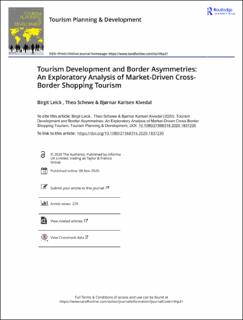Tourism development and border asymmetries: An exploratory analysis of market-driven cross-border shopping tourism
Peer reviewed, Journal article
Published version
Permanent lenke
https://hdl.handle.net/11250/2727224Utgivelsesdato
2020Metadata
Vis full innførselSamlinger
- Institutt for økonomi og it [161]
- Publikasjoner fra CRIStin [3623]
Originalversjon
Leick, B., Schewe, T. & Kivedal, B. K. (2020). Tourism Development and Border Asymmetries: An Exploratory Analysis of Market-Driven Cross-Border Shopping Tourism. Tourism Planning & Development, 1-26. https://doi.org/10.1080/21568316.2020.1837230Sammendrag
This paper explores whether shopping tourism in the context of cross-border regions may trigger more viable, and long-term, tourism despite persistent border asymmetries (e.g., price and tax differences) which are typically key to luring tourists to short-term shopping visits. While tourism development is often an explicit goal of cross-border policy initiatives, this paper is devoted to the market-driven processes that might drive tourism beyond short-term shopping in borderlands. Based upon a case study from the Norwegian-Swedish border region of Østfold-Fyrbodal, it finds that asymmetric cross-border shopping tourism supports the development of a diversified tourism sector with a variety of tourist attractions and services organised around shopping, longer overnight stays and second-home tourism. Despite persistent border asymmetries, market processes may balance off the short-term shopping visits towards supporting long-term tourism, which provides economic value to the cross-border region.

